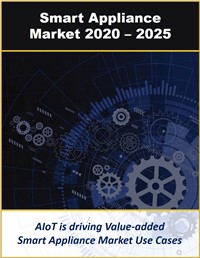This report evaluates the smart appliance marketplace including technologies, companies, solutions, products, and services. The report includes analysis of leading companies and their strategies and offerings. The report evaluates the use of converged AI and IoT systems/solutions known as AIoT to enable intuitive and value-added human-to-machine smart appliance interactions. The report also provides market projections with forecasts covering the period 2020 to 2025 for all major aspects of the smart appliance market including technologies, solutions, applications and services.
Related to Connected Home technologies, smart appliances leverage the Internet of Things (IoT) and are connected to the Cloud and control infrastructure such as utilities/smart grid to enable more efficient and more productive use of electricity. Smart appliances include thermostats, clothes washers, dryers, microwaves, hot water heaters, and refrigerators. Smart appliances rely upon various communications technologies including Wi-Fi, ZigBee, Z-Wave, Bluetooth, and NFC, as well as IoT and related operating systems for consumer command and control such as iOS, Android, Azure, Tizen.
Implementation and operation is becoming increasingly easy for end-users, facilitating rapid growth in the Do-it-Yourself (DIY) segment. Smart grid integrators play an important role defining smart appliance standards through transferring knowledge, testing efficiency, and optimizing systems and networks that would communicate with both utilities and smart appliances. These companies and other entities ensure intelligent appliances receive real-time data from the AMI system to control or modulate their operation.
One of the important areas that Mind Commerce has identified for the smart appliances market is the convergence of AI and IoT, which is also known as the Artificial Intelligence of Things or AIoT. Currently, many AIoT use cases are very retail product oriented, many of which focus on cognitive computing in consumer appliances. Sharp refers to AIoT as “People-Oriented IoT = AIoT” for “more responsive technology” as part of what they refer to as the “Smart Life”. They provide examples of smart homes in which the system learns how its occupants like to live through interaction with smart appliances and housing equipment.
Target Audience:
- IoT ecosystem
- Smartgrid integrators
- Smart appliance companies
- Wireless device manufacturers
- Consumer electronics companies
- Embedded computing companies
- Wireless service providers of all types
- AIoT in home automation market will reach $8.77B globally by 2025
- Smart appliances are evolving to embrace the “as a service” product model
- Combined AI and IoT solutions will drive significant smart appliance market value
- Leading smart appliance vendors are focusing on cloud-based services and improved user interfaces
- The DIY segment for smart home/appliance integration is expected to exceed 50% of total market by 2027



